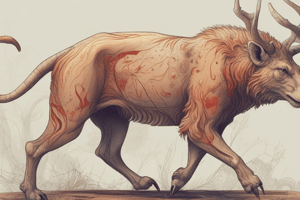Podcast
Questions and Answers
What is responsible for sudden responses to stimuli in animals?
What is responsible for sudden responses to stimuli in animals?
Which systems are involved in control and coordination in both humans and animals?
Which systems are involved in control and coordination in both humans and animals?
What are the five sense organs in the human body called?
What are the five sense organs in the human body called?
What consists of nerve fibres and nerve cells that transmit impulses between different parts of the body?
What consists of nerve fibres and nerve cells that transmit impulses between different parts of the body?
Signup and view all the answers
Which system produces and secretes hormones for control and coordination in humans?
Which system produces and secretes hormones for control and coordination in humans?
Signup and view all the answers
What is the main function of receptors in the human body?
What is the main function of receptors in the human body?
Signup and view all the answers
What is the structural and functional unit of the nervous system?
What is the structural and functional unit of the nervous system?
Signup and view all the answers
Which part of the neuron transmits nerve impulses towards the cell body?
Which part of the neuron transmits nerve impulses towards the cell body?
Signup and view all the answers
What is the function of the Central Nervous System?
What is the function of the Central Nervous System?
Signup and view all the answers
Which part of the brain is responsible for control and coordination of voluntary functions?
Which part of the brain is responsible for control and coordination of voluntary functions?
Signup and view all the answers
What is responsible for bringing information from all parts of the body to the brain?
What is responsible for bringing information from all parts of the body to the brain?
Signup and view all the answers
What covers the Schwann cells in the neuron's axon?
What covers the Schwann cells in the neuron's axon?
Signup and view all the answers
Study Notes
Sudden Responses to Stimuli
- Reflex actions are responsible for immediate responses to stimuli in animals.
Control and Coordination Systems
- The nervous system and endocrine system are both involved in control and coordination in humans and animals.
Human Sense Organs
- Five sense organs in the human body: eyes (sight), ears (hearing), nose (smell), tongue (taste), skin (touch).
Nervous System Components
- The nervous system consists of nerve fibers and nerve cells that transmit impulses between different parts of the body.
Hormonal Regulation
- The endocrine system produces and secretes hormones for control and coordination in humans.
Function of Receptors
- Receptors detect changes in the environment and are essential for sensory perception and response.
Nervous System Unit
- The neuron is the structural and functional unit of the nervous system.
Neuron Structure
- Dendrites are the parts of the neuron that transmit nerve impulses towards the cell body.
Central Nervous System Functions
- The Central Nervous System (CNS) processes information, coordinates actions, and integrates sensory input.
Brain Functions
- The cerebrum is the part of the brain responsible for control and coordination of voluntary functions.
Information Transmission to the Brain
- The sensory neurons carry information from all parts of the body to the brain.
Axon Structure
- Myelin sheath covers the Schwann cells in the neuron's axon, enhancing the speed of nerve impulse transmission.
Studying That Suits You
Use AI to generate personalized quizzes and flashcards to suit your learning preferences.
Description
Explore how animals fall asleep, react to stimuli, and coordinate their movements through a system that allows for quick responses. Learn about the mechanisms behind our daily activities such as sleeping, reacting to hot surfaces, and changing directions while walking.



